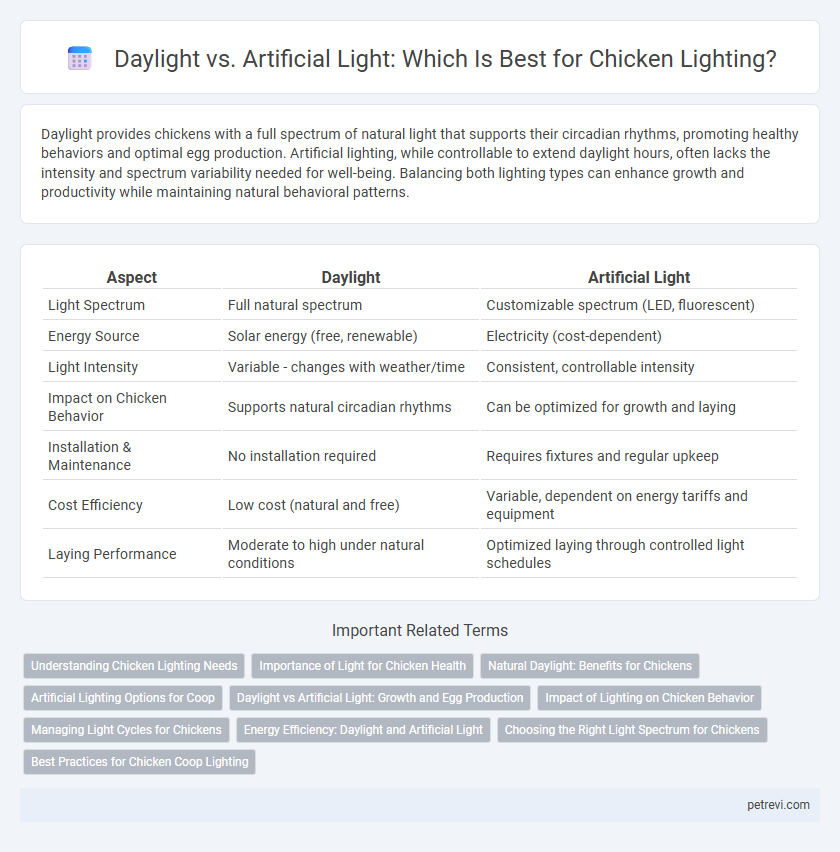Daylight provides chickens with a full spectrum of natural light that supports their circadian rhythms, promoting healthy behaviors and optimal egg production. Artificial lighting, while controllable to extend daylight hours, often lacks the intensity and spectrum variability needed for well-being. Balancing both lighting types can enhance growth and productivity while maintaining natural behavioral patterns.
Table of Comparison
| Aspect | Daylight | Artificial Light |
|---|---|---|
| Light Spectrum | Full natural spectrum | Customizable spectrum (LED, fluorescent) |
| Energy Source | Solar energy (free, renewable) | Electricity (cost-dependent) |
| Light Intensity | Variable - changes with weather/time | Consistent, controllable intensity |
| Impact on Chicken Behavior | Supports natural circadian rhythms | Can be optimized for growth and laying |
| Installation & Maintenance | No installation required | Requires fixtures and regular upkeep |
| Cost Efficiency | Low cost (natural and free) | Variable, dependent on energy tariffs and equipment |
| Laying Performance | Moderate to high under natural conditions | Optimized laying through controlled light schedules |
Understanding Chicken Lighting Needs
Chickens require specific lighting conditions to regulate their circadian rhythms and promote optimal health and egg production. Daylight provides a natural spectrum that supports vitamin synthesis and behavioral patterns, while artificial light must mimic these qualities to prevent stress and ensure consistent productivity. Understanding the intensity, duration, and spectrum of light helps optimize poultry welfare and maximize egg-laying efficiency.
Importance of Light for Chicken Health
Light exposure significantly influences chicken health by regulating circadian rhythms, promoting natural behaviors, and supporting vitamin D synthesis essential for bone development. Daylight provides a full spectrum of light, which enhances poultry wellbeing, improves egg production, and reduces stress compared to artificial lighting. Optimal lighting conditions, combining intensity and duration, are critical for maintaining immune function and overall productivity in poultry farming.
Natural Daylight: Benefits for Chickens
Natural daylight provides chickens with a full spectrum of light essential for regulating their circadian rhythms and promoting healthy behavior patterns. Exposure to sunlight enhances vitamin D synthesis, which is crucial for calcium absorption and eggshell quality, leading to stronger, healthier chickens. Studies show chickens under natural daylight exhibit improved growth rates and reduced stress compared to those raised under artificial lighting.
Artificial Lighting Options for Coop
Artificial lighting options for chicken coops include LED bulbs, fluorescent tubes, and incandescent lamps, each offering different spectral outputs to mimic natural daylight or provide targeted illumination. LED lights are energy-efficient and customizable with adjustable intensity and color temperature, promoting consistent egg production and maintaining circadian rhythms. Fluorescent tubes offer broad-spectrum lighting but may flicker, while incandescent lamps produce heat that can benefit chickens in cooler environments but consume more energy.
Daylight vs Artificial Light: Growth and Egg Production
Daylight provides a natural spectrum that supports optimal chicken growth and enhances egg production by regulating circadian rhythms and hormone levels. Artificial light with specific wavelengths, such as LED or fluorescent bulbs, can be tailored to extend laying periods and stimulate growth but may require careful management to avoid stress. Studies show chickens exposed to balanced daylight often exhibit better overall health and more consistent egg quality compared to those under solely artificial lighting.
Impact of Lighting on Chicken Behavior
Daylight provides a natural spectrum that supports chickens' circadian rhythms, promoting healthier feeding, mating, and nesting behaviors. Artificial light, especially with improper intensity or color temperature, can disrupt these patterns and lead to stress, reduced egg production, and abnormal pecking behavior. Optimizing light duration and spectrum to mimic natural conditions enhances chicken welfare and productivity.
Managing Light Cycles for Chickens
Managing light cycles for chickens involves balancing natural daylight with artificial light to optimize laying performance and behavior. Using timers for artificial lighting ensures consistent photoperiods, typically providing 14-16 hours of light daily to stimulate egg production. Proper light intensity, around 10-20 lux, combined with gradual transitions between light and dark phases, helps maintain circadian rhythms and reduce stress in poultry.
Energy Efficiency: Daylight and Artificial Light
Daylight provides natural full-spectrum light that supports chicken behavior and reduces energy costs by minimizing the need for artificial lighting during daytime. Artificial light systems, particularly LED technology, offer energy-efficient control over light intensity and duration, optimizing poultry production even in low natural light conditions. Balancing natural daylight with advanced artificial lighting ensures optimal energy consumption while maintaining poultry welfare and productivity.
Choosing the Right Light Spectrum for Chickens
Selecting the optimal light spectrum for chickens significantly influences their growth, egg production, and overall health. Natural daylight provides a full spectrum of wavelengths that mimic the sun, promoting natural behaviors and circadian rhythms, while artificial light allows for customization of intensity and color temperature, such as blue and green spectrums known to enhance feeding and activity. Balancing daylight and artificial light ensures chickens receive the appropriate wavelengths to optimize physiological functions and welfare in various poultry environments.
Best Practices for Chicken Coop Lighting
Daylight provides a natural spectrum of light that supports chicken circadian rhythms, improving egg production and overall health. Artificial lighting in chicken coops should mimic natural daylight with full-spectrum LED bulbs, delivering consistent intensity and duration to optimize laying cycles. Best practices for chicken coop lighting recommend 14-16 hours of light daily, balancing natural daylight with artificial light to prevent stress and enhance welfare.
Daylight vs Artificial light for Chicken Lighting Infographic

 petrevi.com
petrevi.com